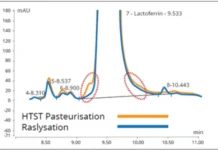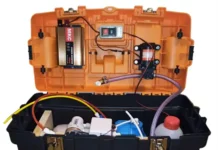IUVA Food and Beverage Safety Working Group
Babak Adeli, director of research and development, Acuva Technologies
Waterborne microorganisms can affect the flavor, color, odor and shelf life of soft drinks, bottled water and a wide variety of food products.1 It is critical that the process water is free from contamination by pathogens and spoilage organisms. In addition to process water, disinfection of the ingredients in food industry recipes, including sugars and proteins that are ideal breeding ground for microorganisms, is critical.2
Ultraviolet (UV) disinfection has gained tremendous attention in the last decade for inactivation of microorganisms and decomposition of organic compounds in process water, as well as beverage products. Currently, conventional UV lamp devices are employed for various applications in the food and beverage industry, including disinfection, total organic compound reduction, ozone destruction and chlorine/chloramines destruction.
However, the application of conventional UV lamps in food and beverage industries faces major challenges due to their undesirable characteristics. Conventional UV lamps contain mercury, which is known as a hazardous material, thus not desirable for a wide spectrum of applications related to the food and beverage industry. Additionally, the heat dissipation from conventional UV lamps results in considerable temperature gradient in the vicinity of the lamp. This is unfavorable for disinfection of many beverages in which their flavor, color, odor and/or shelf life is a strong function of temperature.
Ultraviolet light emitted diodes (UV LEDs) have emerged as a superior alternative to conventional UV lamps, owing to their tailorable optical characteristics, ultra-low power consumption, durability and rapid climbing efficiencies. The formation of a solid solution (alloy) of GaN and AlN results in AlGaN LEDs, with an emission spectrum that can be tuned to the entire ultraviolet spectral range from 210 nm to 400 nm.
Such strong optical characteristics positioned UV LED as a perfectly suited candidate for a wide spectrum of applications, including biological, environmental, industrial and medical. Unlike conventional UV lamps, UV LEDs are solid state light sources and do not contain hazardous compounds.
In addition, the internal design of UV LED packages directs dissipated heat to the package sub-mount, resulting in negligible temperature elevation from the illuminating surface. These characteristics, along with their ultra-low maintenance and compact footprint, makes UV LED disinfection systems one of the most viable and robust solutions for beverage disinfection.
However, the wide-scale application of UV LED disinfection in the food and beverage industry faces critical challenges. In first place, the radiant flux of commercially available germicidal UV LEDs is considerably far from the watt or kilowatt level required for some industrial applications. In fact, the milliwatt-level radiant flux of current UV LEDs has triggered tremendous efforts around the design and commercialization of UV LED water disinfection systems for point of use (PoU) applications, which, consequently, resulted in less focus on the development of industrial scale disinfection systems.
Apart from the critical question – Is the current stage of UV LED technology ready to support large-scale beverage disinfection? – the expertise in the design and validation of large-scale UV LED reactors seems to be extremely limited. It is extremely important to understand that the distribution of UV photons, as well as the fluid hydrodynamics inside an industrial UV photoreactor, could be quite different from PoU UV LED disinfection devices because of the considerable variation in size and operating conditions.
For instance, the degradation of UV fluence rate, due to the potential fluid absorption, could impact the optimal photoreactor dimensions, and/or increase the total required UV power drastically. This will be more challenging, once the UV transmittance of the processing fluid (e.g., soft drinks) reduces, to the extent that in some cases a thin film of fluid must be maintained throughout the photoreactor for a certain level of UV dose/disinfection to be accomplished.
When comparing the external quantum efficiencies (EQEs) and wall plug efficiencies (WPEs) of the state-of-the-art commercially available blue, exceeding 80%,3 it is apparent that UV LEDs are considerably behind their potential with limited EQEs and WPEs of a few percentages. Overall, there seems to be no fundamental challenges in the development of high-efficiency UV LEDs. Last decade’s improvements in EQEs and WQEs suggest that UV LEDs with optical power and efficiencies like those achieved for InGaN-based blue LEDs is well within reach in near future.
In the author’s opinion, such rapid climbing efficiencies will position this newly emerged technology as a viable candidate for large-scale industrial applications, including the disinfection of food and beverage in near future.
The IUVA Food and Beverage Safety Working Group explores the latest updates on the science-based validation and commercialization of UV-C technology for plant growth stimulation or suppression, nutrition enhancement, fungicide and pesticide reduction, wash water sanitation and postharvest disinfection, as well as use for nonthermal, low UVT beverage treatment.
Contact: badeli@acuvatech.com
References
- Hui, Y.H. & Sherkat, F. Handbook of Food Science, Technology, and Engineering – 4 Volume Set. (Taylor and Francis, 2005).
- Sansebastiano, G., Zoni, R. & Bigliardi, L. Cleaning and disinfection procedures in the food industry general aspects and practical applications. in Food Safety: A Practical and Case Study Approach 253–280 (Springer US, 2007). doi:10.1007/978-0-387-33957-3_13.
- Kneissl, M., Seong, T.Y., Han, J. & Amano, H. The emergence and prospects of deep-ultraviolet light-emitting diode technologies. Nature Photonics vol. 13 233–244 (2019).





